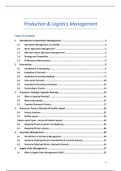Production & Logistics Management
Table of Contents
1 Introduction to Operations Management ................................................................. 3
1.1 Operations Management: an example .......................................................................... 3
1.2 Wat is Operations Management? ................................................................................. 3
1.3 Why learn about Operations Management? ................................................................. 4
1.4 Strategy and Competition ............................................................................................ 5
1.5 Performance Measurement.......................................................................................... 6
2 Forecasting .............................................................................................................. 8
2.1 Introduction to forecasting........................................................................................... 8
2.2 Evaluation of Forecasts ................................................................................................ 9
2.3 Qualitative Forecasting Methods .................................................................................. 9
2.4 Time-series Forecasts ................................................................................................. 10
2.5 Associative Forecasting Techniques ............................................................................ 14
2.6 Forecasting in Practice ............................................................................................... 14
3 Processes: Strategic Capacity Planning ....................................................................16
3.1 What is Capacity Planning? ........................................................................................ 16
3.2 Measuring Capacity.................................................................................................... 16
3.3 Capacity Planning in Practice ...................................................................................... 17
3 Processes: Process Selection & Facility Layout ..........................................................22
3.4 Process Selection ....................................................................................................... 22
3.5 Facility Layout............................................................................................................ 23
4 Basic Layout Types + Service & Cellular Layouts.................................................................... 24
3.6 Designing Product Layouts: Line Balancing .................................................................. 26
3.7 Designing Process Layouts .......................................................................................... 28
4 Inventory Management...........................................................................................30
4.1 Introduction to Inventory Management...................................................................... 30
4.2 Inventory Ordering Policies: Deterministic & Constant Demand .................................. 32
4.3 Inventory Ordering Policies: Stochastic Demand ......................................................... 34
5 Supply Chain Management ......................................................................................37
5.1 What is Supply Chain Management (SCM)? ................................................................ 37
1
, 5.2 Location Decisions ..................................................................................................... 38
Evaluating Location Alternatives (4)........................................................................................ 39
5.3 Inventory Management and Bullwhip Effect ............................................................... 41
5.4 Order Fulfilment and Customer Order Decoupling Point.............................................. 43
5.5 Designing for Supply Chain Efficiency.......................................................................... 44
5.6 Sustainable Supply Chains .......................................................................................... 45
6 Manufacturing Planning and Control .......................................................................46
6.1 Manufacturing Planning and Control (MPC) ................................................................ 46
6.2 Enterprise Resource Planning (ERP) ............................................................................ 46
6.3 Aggregate Planning .................................................................................................... 47
Aggregate Planning Strategies ................................................................................................ 49
Aggregate Planning Techniques .............................................................................................. 51
6.4 Aggregate Planning in Services ................................................................................... 52
6.5 Master Scheduling ..................................................................................................... 53
6.6 Material Requirements Planning (MRP) ...................................................................... 55
Scheduling ......................................................................................................................61
6.7 Introduction to Scheduling ......................................................................................... 61
6.8 High-Volume Systems and intermediate-Volume Systems ........................................... 61
6.9 Scheduling in Low-volume Systems ............................................................................ 63
6.10 Scheduling Services .................................................................................................... 66
2
, 1 Introduction to Operations Management
1.1 Operations Management: an example
Eg: cheeseburger stand: How to organize all the tasks? → keep customers happy
Problems vs Solutions: production lead time vs preferred waiting time, stock vs fresh, etc.
→ inventory, staff, preparations, forecasting, optimize process, planning, concept, loyalty,
risk management (1 vs many suppliers), product and service offering, cut waste, save money…
1.2 Wat is Operations Management?
• “Operations management is the planning, scheduling, and control of the activities that
transform inputs into finished goods and services”
• “OM deals with the design and management of products, processes, services and supply
chains. It considers the acquisition, development, and utilization of resources that firms
need to deliver the goods and services their clients want.”
• “The responsibility of ensuring that business operations are efficient in terms of using as
few resources as needed, and effective in terms of meeting customer requirements. It is
concerned with managing the transformation process that converts inputs (in the forms
of raw materials, labor, and energy) into outputs (goods and/or services).”
Supply chain = a sequence of activities and organizations involved in producing and delivering
a good or service. It is broader and looks further than the company as an individual.
Operations Management =
Managing Transformation Processes
making these transformation
processes as effective and efficient as
possible by measuring: set up quality
standards and get + check feedback
→ improve your transformation
could also be that input should be
changed to optimize the output (eg
bad products from the supplier)
decide what to measure and
what/how to follow up
→OM tools can be applied to ensure that resources are used as efficiently as possible / OM tools
can be used to make desirable trade-offs between competing objectives / OM tools can be used to
redesigned or restructure our operations so that we can improve performance along multiple
dimensions simultaneously
• Material Processors: food production, automotive, assembly, retail operations, warehousing and
distribution, transport
• Information Processors: accountants, financial analysts, news service, archives, telecom company
• People Processors: hairdressers, hotels, hospitals, theatres, theme parks, dentists, schools
3





